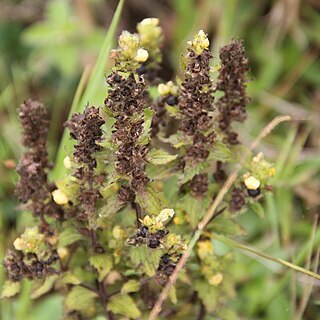Lower leaves truncate, rounded or cordate at base, sessile or sometimes with a small, slender petiole about 1 mm long, upper leaves often cuneate and petiolate; lamina suborbicular, broadly ovate to ovate, subentire to deeply toothed, obtuse to acute at apex, spreading, pubescent; stem usually densely pubescent with erect white hairs; calyx ciliate on nerves and margin; the two longer filaments always bearded.
Leaves opposite, alternate within inflorescence, 14–25(55) x 8–18(28) mm., shape very varied from circular to ovate to broadly or narrowly lanceolate, subentire or crenate to coarsely toothed, acute or obtuse, sessile or subsessile to shortly petiolate, acute, cuneate, rounded to cordate at base, appressed or subappressed to spreading, hispid to subglabrous.
All leaves distinctly petiolate, cuneate to rounded at base; lamina oblong-lanceolate to lanceolate, rarely ovate, distinctly and often deeply toothed, subacute at apex, shortly and roughly pubescent to nearly glabrous; stem more or less appresssed-pubescent to subglabrous; calyx ciliate on nerves and margin; the two longer filaments always bearded.
This is a very complicated species which has, in the main, been clarified by Hepper (in Kew Bull. 14: 405, 1960). In this work he acknowledges three varieties encompassing most of the names which have represented elements of this complex over the years. For the purpose of this work I have chosen to follow his treatment and apply his criteria here.
Erect, parasitic annual herb, up to 120 mm tall. Stem and branches hispid with whitish, spreading hairs, leafy. Leaves opposite or subopposite, sessile, ovate. Flowers in axils of upper leaves, forming terminal, leafy or bracteate spikes. Flowers deep cream.
Erect, parasitic herb, up to 300 mm tall. Stem ap-pressed-pubescent to subglabrous. All leaves distinctly petiolate, cuneate to rounded at base, lamina oblong-lanceolate to lanceolate, distinctly and often deeply toothed. Flowers yellow.
Hemiparasitic perennial to 25 cm. Leaves coarsely toothed below, spreading, longer than flower buds. Flowers in spikes or racemes, yellow to orange, stamens unequal, filaments glabrous.
Calyx 6–8 mm. long, 10-nerved, glabrous to ciliate on nerves and margins of lobes, very rarely overall; lobes 3–5 mm. long, subequal, triangular, acute.
Corolla pale yellow to dull orange, at times with reddish-purple venation, campanulate, early marcescent, slightly or up to one third longer than calyx.
Flowers solitary in axils of leaves or leaf-like bracts; pedicels absent or about 0.5 mm. long, rarely up to 1.5 mm. long.
Erect annual, (5)15–50(60) cm. tall; stems straight, slender to stout, simple orbranched, pilose to variously hispid.
Bracts leaf-like, longer or shorter than flowers, usually coarsely toothed, coarsely hairy to subglabrous, ciliate.
Bracteoles linear, subulate to filiform, equalling or slightly shorter than calyx, hairy ciliate to glabrous.
Stamens unequal, longer filaments bearded, very rarely all glabrous; anther thecae apiculate.
Capsule about 5.5 x 5.5 mm., spherical, glabrous.
Petiole 0–2(3) mm. long.

